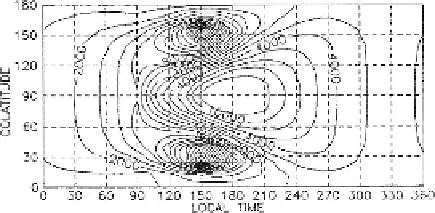Geoscience Reference
In-Depth Information
Fig. 9.2.
The ionospheric equivalent current induced by a field-aligned current
flowing into the Northern hemisphere at 09.00 LT and outflowing at the same
time from the Southern hemisphere. Equinox. The geomagnetic field is d
ipole-
like.
Σ
P
and
Σ
H
depend on latitude and lo
cal ti
me as
Σ
P
(
θ
,t
)=
Σ
P
0
√
cos
Z
(day),
Σ
P
=
Σ
P
0
/
30 (night);
Σ
H
(
θ
,t
)=
√
cos
Z
(day),
Σ
H
=
Σ
H
0
/
30 (night);
Σ
P
0
=3Ohm
−
1
,Σ
H
0
=5Ohm
−
1
. The sunrise and sunset terminators coincide with
longitudes 90
◦
and 270
◦
respectively, or with the local time meridian 06.00 LT and
18.00 LT
If the ionospheric conductivity distribution is a continuous function of the
coordinates, the spatial distribution of solenoidal currents
Ψ
sol
and magnetic
field as well are quite complicated, even for the localized field-aligned currents
and a simple spatial dependence of
Σ
p
and
Σ
H
. Let us assume that there is
a system of two field-aligned currents with one of them flowing out from the
Southern Hemisphere, and the other flowing into the Northern Hemisphere,
each of them generates a solenoidal current system in the ionosphere. Fig-
ure 9.2 shows the solenoidal current system
Ψ
sol
for equinox conditions with
field-aligned currents as specified above, and localized at latitudes 67
◦
N
and
67
◦
S
, on local time meridian 150
◦
. The geomagnetic field is dipole-like.
Elements of the ionospheric conductivity tensor depend on the Sun's zenith
angle. Even in such a simple case, when conductivities are symmetrical with
respect to the noon meridian, there is no a symmetrical spatial distribution
of the solenoidal current system
Ψ
sol
.
At the sunrise hours (
90
◦
) the solenoidal current system is transformed
more significantly because its source is close to the terminator. The equivalent
current turns near the sunrise terminator and aligns with the low and equa-
torial latitudes along the terminator. There is an additional current vortex on
the sunlit part of the ionosphere associated with the mutual penetration of
equivalent currents in both hemispheres due to the interaction between the
current systems in them.
The magnetic field in the equatorial region is directed along a parallel
and the terminator does not influence the rotation of the magnetic vector
under the ionosphere. The latter statement is valid, of course, for arbitrary
odd disturbances during the equinox. The odd disturbances in terms of field-
aligned currents mean that a pair of currents of the opposite direction in the
conjugate points in the Northern and Southern Hemispheres is considered.
∼

Search WWH ::

Custom Search